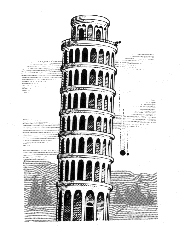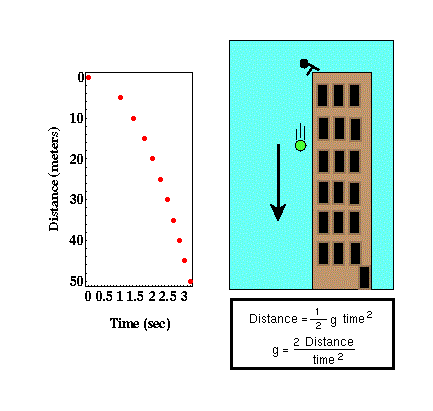Falling Body Measurements

The gravitational acceleration can be measured directly by dropping an object and measuring its time rate of change of speed (acceleration) as it falls. By tradition, this is the method we have commonly ascribed to Galileo Galilei. In this experiment, Galileo is supposed to have dropped objects of varying mass from the leaning tower of Pisa and found that the gravitational acceleration an object undergoes is independent of its mass. He is also said to have estimated the value of the gravitational acceleration in this experiment. While it is true that Galileo did make these observations, he didn't use a falling body experiment to do them. Rather, he used measurements based on pendulums.
It is easy to show that the distance a body falls is proportional to the time it has fallen squared. The proportionality constant is the gravitational acceleration, g. Therefore, by measuring distances and times as a body falls, it is possible to estimate the gravitational acceleration. To measure changes in the gravitational acceleration down to 1 part in 40 million using an instrument of reasonable size (say one that allows the object to drop 1 meter), we need to be able to measure changes in distance down to 1 part in 10 million and changes in time down to 1 part in 100 million!! As you can imagine, it is difficult to make measurements with this level of accuracy.

It is, however, possible to design an instrument capable of measuring accurate distances and times and computing the absolute gravity down to 1 microgal (0.001 mgals; this is a measurement accuracy of almost 1 part in 1 billion!!). Micro-g LaCoste is one manufacturer of this type of instrument, known as an Absolute Gravimeter. Unlike the instruments described next, this class of instruments is the only field instrument designed to measure absolute gravity. That is, this instrument measures the size of the vertical component of gravitational acceleration at a given point. As described previously, the instruments more commonly used in exploration surveys are capable of measuring only the change in gravitational acceleration from point to point, not the absolute value of gravity at any one point.
Although absolute gravimeters are more expensive than the traditional, relative gravimeters and require a longer station occupation time (1/2 day to 1 day per station), the increased precision offered by them and the fact that the looping strategies described later are not required to remove instrument drift or tidal variations may outweigh the extra expense in operating them. This is particularly true when survey designs require large station spacings or for experiments needing the continuous monitoring of the gravitational acceleration at a single location. As an example of this latter application, it is possible to observe as little as 3 mm of crustal uplift over time by monitoring the change in gravitational acceleration at a single location with one of these instruments.
Gravity
- Overviewpg 12
- -Temporal Based Variations-
- Instrument Driftpg 13
- Tidespg 14
- A Correction Strategy for Instrument Drift and Tidespg 15
- Tidal and Drift Corrections: A Field Procedurepg 16
- Tidal and Drift Corrections: Data Reductionpg 17
- -Spatial Based Variations-
- Latitude Dependent Changes in Gravitational Accelerationpg 18
- Correcting for Latitude Dependent Changespg 19
- Vari. in Gravitational Acceleration Due to Changes in Elevationpg 20
- Accounting for Elevation Vari.: The Free-Air Correctionpg 21
- Variations in Gravity Due to Excess Masspg 22
- Correcting for Excess Mass: The Bouguer Slab Correctionpg 23
- Vari. in Gravity Due to Nearby Topographypg 24
- Terrain Correctionspg 25
- Summary of Gravity Typespg 26